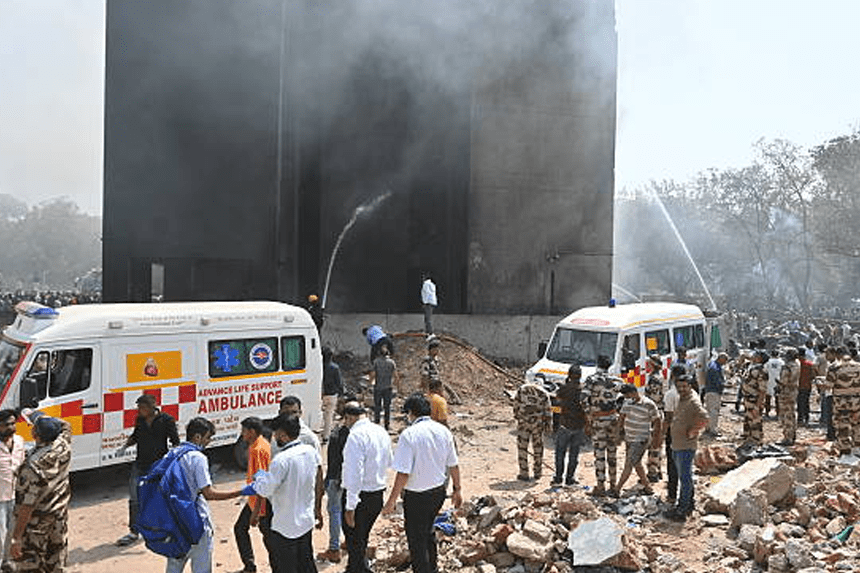Authorities have confirmed that the Air India tragedy that rocked Ahmedabad still has sad results, as 270 people have died. Shortly after takeoff, the London-bound Boeing 787-8 Dreamliner smashed into a residential complex serving as hospital accommodation. One passenger escaped the terrible crash. Now the country struggles with loss as the inquiry, supported by US and UK specialists, seeks the reason. India’s response to one of its biggest air tragedies in recent memory consists of vigils, DNA identification, and urgent fleet inspections.
- Who remains missing, and what is the present death toll?
- What effect on the ground population did the Crash have?
- Where have Vigils and Mourning been placed?
- How Are Families Finding and Identifying Their Loved Ones?
- What stages of the investigation have thus far been reached?
- What is the record of history and maintenance for the aircraft?
- Safety precautions mandated by authorities following a crash?
- How Have Authorities and Leaders from Airlines Reacted?
- From what other general aviation lessons should one draw?
- Finally, after this tragedy, what is the road forward?
Who remains missing, and what is the present death toll?
Officials of the BJ Medical College and Civil Hospital claim tha,t thus f,ar 270 dead have been found. Of them, 241 are thought to be staff and passengers on Air India Flight AI171. Sadly, one of the 242 people on board died in the collision. Forty-year-old British national Vishwashkumar Ramesh, the solitary survivor, is still in a critical state and under hospital treatment.
Determining the exact number of ground-based civilian casualties is still under active investigation. The impact of the aircraft demolished a structure used as hospital doctors’ staff quarters, sparking concerns about further deaths not originally recorded. Here is the link to our article on Delta Crash Toronto
What effect on the ground population did the Crash have?
Just seconds after takeoff, the jet slammed into a highly populated location. It particularly affected the residential complex housing junior doctors at the Civil Hospital. The incident set the building on fire and added to the high death toll by causing a big explosion.
Emergency services have had to operate in quite trying circumstances. Rescuers keep looking through the debris to make sure no more is caught under. To look for structural damage and additional injuries, authorities have begun knocking on the doors of surrounding buildings.
Where have Vigils and Mourning been placed?
Grief over the Air India crash is not confined to India. On Sunday night, some hundred mourners assembled outside the High Commission of India in London the United Kingdom. To honor the people lost in the catastrophe, they set floral tributes and lit candles. Many in the throng were friends, relatives, and members of local groups linked to the victims.
Memorial ceremonies have been planned back in India in Mumbai, New Delhi, and Ahmedabad. Calling for prayers, religious leaders from many backgrounds show solidarity with the victims and their families. Many Ahmedabad locals have also stepped forward to help the bereaved.
How Are Families Finding and Identifying Their Loved Ones?
Finding the victims depends now mostly on DNA matching. So far, officials say, more than thirty people have been favorably identified using DNA samples supplied by families. Families, many of which have travelled great distances to get the remains of their loved ones, find the process difficult and emotionally exhausting, nevertheless.
Working with impacted families, community leaders have demanded openness and expediency during the identification process. Many Indian societies allow families to start the burial or cremation rites, but many still find themselves in hospitals awaiting results, unable to start the process of closure. Here is the link to our article on Cairns Helicopter Crash
What stages of the investigation have thus far been reached?
The investigation into the Air India crash is under direction by India’s Aircraft Accident Investigation Bureau (AAIB). Investigative teams from the United States and the United Kingdom are helping them as they have knowledge in aircraft accident forensics.
Friday saw a significant breakthrough when the black box of the airplane was recovered. The black box’s contents, according to India’s civil aviation minister, Ram Mohan Naidu Kinjarapu, would “significantly help the inquiry.” Although a comprehensive investigation is still in progress, preliminary results point to a catastrophic mechanical failure.
What is the record of history and maintenance for the aircraft?
Data from flight-tracking service Flightradar24 indicates that the Boeing Dreamliner 787-8 involved in the Air India tragedy was 11 years old. Over the past two years, it has made 25 international flights from Ahmedabad to London Gatwick.
Before takeoff, the aircraft had passed regular pre-flight inspections; nonetheless, authorities are now closely examining the aircraft’s maintenance record. Among the several possible explanations under examination are technical design flaws, mechanical malfunction, and pilot error.
Safety precautions mandated by authorities following a crash?
India’s Directorate General of Civil Aviation (DGCA) has mandated emergency safety inspections on all Air India Boeing 787-8 and 787-9 aircraft in response to the accident. Although these checks are labeled as “preventive,” given the crash’s conditions, they are rather crucial.
While boosting public confidence in air travel, experts believe this proactive approach could stop such catastrophes. Critics counter that more thorough control ought to have been in place sooner, particularly for long-haul aircraft flying crowded international routes.
How Have Authorities and Leaders from Airlines Reacted?
On Friday, Indian Prime Minister Narendra Modi visited the crash site, followed by the hospital treatingthe wounded. Spending time with relatives and survivors, he said, “the entire nation is praying for their speedy recovery.”
Additionally, visiting the crash site and the hospital was Air India CEO Campbell Wilson. Declaring the scene to be “deeply moving,” he vowed complete cooperation with investigations and committed to ongoing support of impacted families.
The airline has also set up a helpline for relatives looking for information and declared financial compensation for victim families.
From what other general aviation lessons should one draw?
The Air India accident emphasizes how urgently aviation safety procedures, emergency readiness, and open regulatory control transparency need review. Although flying is usually safe, events like these remind us all that systematic inspections and pilot training are never to be taken lightly.
Although international cooperation in crash investigation is commendable, experts advise that the results ought to be turned into legally enforced changes. As investigations go on, both passengers and authorities may be more closely examining global airline, —especially those running aging aircraft.
Finally, after this tragedy, what is the road forward?
The Air India crash leaves a deep scar on the public conscience but also offers an opportunity for reflection and necessary reform. As families mourn the loss of loved ones, authorities must ensure a thorough investigation that leads to lasting improvements in aviation safety. From black box analysis to nationwide fleet checks, steps are being taken to uncover the truth. However, only time will tell if these measures can prevent similar disasters. For now, the world mourns with the victims, standing in solidarity with a grieving nation seeking answers and healing.








